Optimal Land Selection for Agricultural Purposes Using Hybrid Geographic Information System–Fuzzy Analytic Hierarchy Process–Geostatistical Approach in Attur Taluk, India: Synergies and Trade-Offs Among Sustainable Development Goals
Abstract
:1. Introduction
2. Materials and Methods
2.1. Study Area
2.2. Datasets and Methodology
2.2.1. Fieldwork and Data Preparation
- Topographical Elements
- Climatic Variables
- Soil Physicochemical Factors
2.2.2. Geostatistics and Spatial Variability Mapping
2.2.3. Geographic Information System (GIS)-Based Fuzzy Analytical Hierarchy Process (FAHP) Approach
- Step (1)
- Step (2)
- Step (3)
- Step (4)
- Step (5)
- Step (6)
2.2.4. Generating Agricultural Land Suitability (AgLS) Maps
- Step (1)
- Step (2)
- Step (3)
- Step (4)
- Step (5)
2.2.5. Model Validation
2.2.6. Correlation of Research Outcomes to Sustainable Development Goals (SDGs)
3. Results and Discussion
3.1. Geostatistics and Spatial Variability of Soil Properties
3.2. Contribution of Thematic Layers for Agriculture Suitability
3.2.1. Topographical Factors
3.2.2. Climatic Factors
3.2.3. Soil Texture (ST)
3.2.4. Soil Chemical Contents
3.3. Mapping and Validation of Agricultural Land Suitability (AgLS) Models
3.4. Correlation of Study Outcomes to Sustainable Development Goals (SDGs)
3.4.1. Reinforcing Linkages
- Environmental-Related SDGs
- Economic-Related SDGs
- Social-Related SDGs
3.4.2. Conflicting Linkages
- Environmental-Related SDGs
- Economic-Related SDGs;
- Social-Related SDGs;
3.4.3. Sustainable Action Plan (SAP)
4. Limitations and Future Research Directions
5. Conclusions
Supplementary Materials
Author Contributions
Funding
Institutional Review Board Statement
Informed Consent Statement
Data Availability Statement
Acknowledgments
Conflicts of Interest
References
- Saito, Y.; Syvitski, J.P.M. Morphodynamics of deltas under the influence of humans. Glob. Planet. Chang. 2007, 57, 261–282. [Google Scholar]
- Kilic, O.M.; Gunal, H. Spatial-temporal changes in rainfall erosivity in Turkey using CMIP5 global climate change scenario. Arab. J. Geosci. 2021, 14, 12. [Google Scholar] [CrossRef]
- IPCC. Climate Change 2013—The Physical Science Basis. In Soil Chemical Analysis; Prentice Hall, Inc.: Englewood Cliffs, NJ, USA, 2013. [Google Scholar]
- Rama Rao, C.A.; Raju, B.M.K.; Subba Rao, A.V.M.; Rao, K.V.; Rao, V.U.M.; Ramachandran, K.; Venkateswarlu, B.; Sikka, A.K.; Srinivasa Rao, M.; Maheswari, M.; et al. A district level assessment of vulnerability of Indian agriculture to climate change. Curr. Sci. 2016, 110, 1939–1946. [Google Scholar] [CrossRef]
- Tian, X.; Engel, B.A.; Qian, H.; Hua, E.; Sun, S.; Wang, Y. Will reaching the maximum achievable yield potential meet future global food demand? J. Clean. Prod. 2021, 294, 126285. [Google Scholar] [CrossRef]
- Saqr, A.M.; Nasr, M.; Fujii, M.; Yoshimura, C.; Ibrahim, M.G. Monitoring of Agricultural Expansion Using Hybrid Classification Method in Southwestern Fringes of Wadi El-Natrun, Egypt: An Appraisal for Sustainable Development. In Environment and Sustainable Development. ACESD 2022. Environmental Science and Engineering; Ujikawa, K., Ishiwatari, M., Hullebusch, E.V., Eds.; Springer: Singapore, 2023; pp. 349–362. [Google Scholar] [CrossRef]
- Naidu, L.G.K.; Ramamurthy, V.; Challa, O.; Hedge, R.; Krishnan, P. Manual Soil Site Suitability Criteria for Major Crops; NBSS Publication No. 129; National Bureau of Soil Survey and Land Use Planning (NBSS & LUP): Nagpur, Indian, 2006.
- Alao, J.O.; Ayejoto, D.A.; Fahad, A.; Mohammed, M.A.A.; Saqr, A.M.; Joy, A.O. Environmental Burden of Waste Generation and Management in Nigeria. In Technical Landfills and Waste Management; Springer Water, Part F2824; Springer: Cham, Switzerland, 2024; pp. 27–56. [Google Scholar] [CrossRef]
- El Baroudy, A.A. Mapping and evaluating land suitability using a GIS-based model. Catena 2006, 140, 96–104. [Google Scholar] [CrossRef]
- Sharma, R.; Kamble, S.S.; Gunasekaran, A. Big GIS analytics framework for agriculture supply chains: A literature review identifying the current trends and future perspectives. Comput. Electron. Agric. 2018, 155, 103–120. [Google Scholar] [CrossRef]
- Mendas, A.; Delali, A. Integration of MultiCriteria Decision Analysis in GIS to develop land suitability for agriculture: Application to durum wheat cultivation in the region of Mleta in Algeria. Comput. Electron. Agric. 2012, 83, 117–126. [Google Scholar] [CrossRef]
- Saqr, A.M.; Nasr, M.; Fujii, M.; Yoshimura, C.; Ibrahim, M.G. Optimal Solution for Increasing Groundwater Pumping by Integrating MODFLOW-USG and Particle Swarm Optimization Algorithm: A Case Study of Wadi El-Natrun, Egypt. In Proceedings of the 2022 12th International Conference on Environment Science and Engineering (ICESE 2022), Environmental Science and Engineering, Beijing, China, 2–5 September 2022; Chen, X., Ed.; Springer: Singapore, 2023; pp. 59–73. [Google Scholar] [CrossRef]
- Saqr, A.M.; Ibrahim, M.G.; Fujii, M.; Nasr, M. Simulation-Optimization Modeling Techniques for Groundwater Management and Sustainability: A Critical Review. Adv. Eng. Forum 2022, 47, 89–100. [Google Scholar] [CrossRef]
- Metwally, M.S.; Shaddad, S.M.; Liu, M.; Yao, R.J.; Abdo, A.I.; Li, P.; Jiao, J.; Chen, X. Soil properties spatial variability and delineation of site-specific management zones based on soil fertility using fuzzy clustering in a hilly field in Jianyang, Sichuan, China. Sustainability 2019, 11, 7084. [Google Scholar] [CrossRef]
- Saha, S.; Sarkar, D.; Mondal, P.; Goswami, S. GIS and multi-criteria decision-making assessment of sites suitability for agriculture in an anabranching site of sooin river, India. Model. Earth Syst. Environ. 2021, 7, 571–588. [Google Scholar] [CrossRef]
- Saaty, T.L. The Analytic Hierarchy Process: Planning, Priority Setting, Resource Allocation; McGraw-Hill: New York, NY, USA, 1980; pp. 1–287. [Google Scholar]
- Saqr, A.M.; Ibrahim, M.G.; Fujii, M.; Nasr, M. Sustainable Development Goals (SDGs) Associated with Groundwater Over-Exploitation Vulnerability: Geographic Information System-Based Multi-criteria Decision Analysis. Nat. Resour. Res. 2021, 30, 4255–4276. [Google Scholar] [CrossRef]
- Chang, D.-Y. Applications of the extent analysis method on fuzzy AHP. Eur. J. Oper. Res. 1996, 95, 649–655. [Google Scholar] [CrossRef]
- Noman, M.; Ullah, I.; Khan, M.A.; Qazi, A.; Farooq, W.; Saqr, A.; Elsheikh, A. Analysis of overcurrent protective relaying as minimum adopted fault protection for small-scale hydropower plants. Int. J. Environ. Sci. Technol. 2024, 21, 4457–4470. [Google Scholar] [CrossRef]
- Paudel, G.; Pant, R.R.; Joshi, T.R.; Saqr, A.M.; Ðurin, B.; Cetl, V.; Kamble, P.N.; Bishwakarma, K. Hydrochemical Dynamics and Water Quality Assessment of the Ramsar-Listed Ghodaghodi Lake Complex: Unveiling the Water-Environment Nexus. Water 2024, 16, 3373. [Google Scholar] [CrossRef]
- Foley, J.A.; Ramankutty, N.; Brauman, K.A.; Cassidy, E.S.; Gerber, J.S.; Johnston, M.; Mueller, N.D.; O’Connell, C.; Ray, D.K.; West, P.C.; et al. Solutions for a cultivated planet. Nature 2011, 478, 337–342. [Google Scholar] [CrossRef] [PubMed]
- Choudhary, K.; Boori, M.S.; Shi, W.; Valiev, A.; Kupriyanov, A. Agricultural land suitability assessment for sustainable development using remote sensing techniques with analytic hierarchy process. Remote Sens. Appl. Soc. Environ. 2023, 32, 101051. [Google Scholar] [CrossRef]
- Panneerselvam, B.; Muniraj, K.; Thomas, M.; Ravichandran, N.; Bidorn, B. Identifying influencing groundwater parameter on human health associate with irrigation indices using the Automatic Linear Model (ALM) in a semi-arid region in India. Environ. Res. 2021, 202, 111778. [Google Scholar] [CrossRef] [PubMed]
- Pathak, H.; Fagodiya, R.K. Nutrient Budget in Indian Agriculture During 1970–2018: Assessing Inputs and Outputs of Nitrogen, Phosphorus, and Potassium. J. Soil Sci. Plant Nutr. 2022, 22, 1832–1845. [Google Scholar] [CrossRef]
- Sundaralingam, K.; Biswal, T.K.; Thirukumaran, V. Strain analysis of the Salem-Attur shear zone of Southern Granulite Terrane around Salem, Tamil Nadu. J. Geol. Soc. India 2017, 89, 5–11. [Google Scholar] [CrossRef]
- Şener, Ş.; Şener, E.; Nas, B.; Karagüzel, R. Combining AHP with GIS for landfill site selection: A case study in the Lake Beyşehir catchment area (Konya, Turkey). Waste Manag. 2010, 30, 2037–2046. [Google Scholar] [CrossRef] [PubMed]
- Roy, S.; Singha, N.; Bose, A.; Basak, D.; Chowdhury, I.R. Multi-influencing factor (MIF) and RS–GIS-based determination of agriculture site suitability for achieving sustainable development of Sub-Himalayan region, India. Environ. Dev. Sustain. 2023, 25, 7101–7133. [Google Scholar] [CrossRef]
- Moshago, S.; Regassa, A.; Yitbarek, T. Characterization and Classification of Soils and Land Suitability Evaluation for the Production of Major Crops at Anzecha Watershed, Gurage Zone, Ethiopia. Appl. Environ. Soil Sci. 2022, 2022, 9733102. [Google Scholar] [CrossRef]
- USGS. Homepage. Available online: https://earthexplorer.usgs.gov/ (accessed on 3 December 2024).
- Available online: https://globalweather.tamu.edu/ (accessed on 3 December 2024).
- Ghimire, U.; Akhtar, T.; Shrestha, N.K.; Paul, P.K.; Schürz, C.; Srinivasan, R.; Daggupati, P. A Long-term Global Comparison of IMERG and CFSR with Surface Precipitation Stations. Water Resour. Manag. 2022, 36, 5695–5709. [Google Scholar] [CrossRef]
- Available online: https://tnau.ac.in/site/kvk-salem/soil-and-water-testing-3/ (accessed on 23 June 2023).
- Jackson, M.L. Soil chemical analysis. J. Frankl. Inst. 1958, 265, 356. [Google Scholar] [CrossRef]
- Bouyoucos, G.J. The hydrometer as a new method for the mechanical analysis of soils. Soil Sci. 1927, 23, 343–353. [Google Scholar] [CrossRef]
- Black, I.; Walkley, A.J. Estimation of soil organic carbon by the chromic acid titration method. Soil Sci. 1934, 37, 29–38. [Google Scholar]
- Subbiah, B.V.; Asija, G.L. A rapid procedure for determination of available nitrogen in soils. Curr. Sci. 1956, 25, 259–260. [Google Scholar]
- Olsen, S.R.; Cole, C.V.; Watandbe, F.; Dean, L. Estimation of Available Phosphorus in Soil by Extraction with sodium Bicarbonate. J. Chem. Inf. Model. 1954, 53, 1689–1699. [Google Scholar]
- Stanford, S.; English, L. Use of flame photometer in rapid soil tests of K and Ca. J. Agron. 1949, 41, 446–447. [Google Scholar] [CrossRef]
- Shit, P.K.; Bhunia, G.S.; Maiti, R. Spatial analysis of soil properties using GIS based geostatistics models. Model. Earth Syst. Environ. 2016, 2, 2. [Google Scholar] [CrossRef]
- Selmy, S.; El-Aziz, S.A.; El-Desoky, A.; El-Sayed, M. Characterizing, predicting, and mapping of soil spatial variability in Gharb El-Mawhoub area of Dakhla Oasis using geostatistics and GIS approaches. J. Saudi Soc. Agric. Sci. 2022, 21, 383–396. [Google Scholar] [CrossRef]
- Burrough, P.A.; McDonnell, R.A. Principles of Geographical Information Systems; Taylor & Francis, Ltd.: Abingdon, UK, 1998; Volume 75, p. 422. [Google Scholar]
- Siska, P.P.; Goovaerts, P.; Hung, I.K.; Bryant, V.M. Predicting ordinary kriging errors caused by surface roughness and dissectivity. Earth Surf. Process. Landf. 2005, 30, 601–612. [Google Scholar] [CrossRef]
- Mikhailov, L.; Tsvetinov, P. Evaluation of services using a fuzzy analytic hierarchy process. Appl. Soft Comput. J. 2004, 5, 23–33. [Google Scholar] [CrossRef]
- Reddy, G.M. Trapezoidal fuzzy numbers in extent analysis method in fuzzy AHP. Int. J. Concept. Comput. Inf. Technol. 2015, 3, 69–71. [Google Scholar]
- Buckley, J.J.; Feuring, T.; Hayashi, Y. Fuzzy hierarchical analysis. In Proceedings of the 1999 IEEE International Fuzzy Systems. Conference Proceedings (Cat. No.99CH36315), Seoul, Republic of Korea, 22–25 August 1999; Volume 2. [Google Scholar]
- Meyer, V.; Scheuer, S.; Haase, D. A multicriteria approach for flood risk mapping exemplified at the Mulde river, Germany. Nat. Hazards 2009, 48, 17–39. [Google Scholar] [CrossRef]
- Aly, M.H.; Giardino, J.R.; Klein, A.G. Suitability assessment for New Minia City, Egypt: A GIS approach to engineering geology. Environ. Eng. Geosci. 2005, 11, 259–269. [Google Scholar] [CrossRef]
- Sathiyamurthi, S.; Subbarayan, S.; Ramya, M.; Sivasakthi, M.; Gobi, R.; Qaysi, S.; Praveen Kumar, S.; Lee, J.; Alarifi, N.; Wahba, M.; et al. Advancing Agricultural Land Suitability in Urbanized Semi-Arid Environments: Insights from Geospatial and Machine Learning Approaches. ISPRS Int. J. Geo-Inf. 2024, 13, 436. [Google Scholar] [CrossRef]
- FAO. A Framework for Land Evaluation; Soils Bulletin No. 32; FAO: Rome, Italy, 1976; pp. 59–92. Available online: https://www.fao.org/3/x5310e/x5310e00.htm (accessed on 3 December 2024).
- Sepehri, M.; Malekinezhad, H.; Jahanbakhshi, F.; Ildoromi, A.R.; Chezgi, J.; Ghorbanzadeh, O.; Naghipour, E. Integration of interval rough AHP and fuzzy logic for assessment of flood prone areas at the regional scale. Acta Geophys. 2020, 68, 477–493. [Google Scholar] [CrossRef]
- Das, S. Geospatial mapping of flood susceptibility and hydro-geomorphic response to the floods in Ulhas basin, India. Remote Sens. Appl. Soc. Environ. 2019, 14, 60–74. [Google Scholar] [CrossRef]
- Bogunovic, I.; Mesic, M.; Zgorelec, Z.; Jurisic, A.; Bilandzija, D. Spatial variation of soil nutrients on sandy-loam soil. Soil Tillage Res. 2014, 144, 174–183. [Google Scholar] [CrossRef]
- Wilding, L.P. Spatial variability: Its documentation, accommodation and implication to soil surveys. In Soil Spatial Variability; Pudoc: Wageningen, The Netherlands, 1985; pp. 166–189. [Google Scholar]
- Trigalet, S.; Gabarrón-Galeote, M.A.; Van Oost, K.; van Wesemael, B. Changes in soil organic carbon pools along a chronosequence of land abandonment in southern Spain. Geoderma 2016, 268, 14–21. [Google Scholar] [CrossRef]
- Cooksey, R.W. Descriptive Statistics for Summarising Data. In Illustrating Statistical Procedures: Finding Meaning in Quantitative Data; Springer: Singapore, 2020; pp. 61–139. [Google Scholar] [CrossRef]
- Soropa, G.; Mbisva, O.M.; Nyamangara, J.; Nyakatawa, E.Z.; Nyapwere, N.; Lark, R.M. Spatial variability and mapping of soil fertility status in a high-potential smallholder farming area under sub-humid conditions in Zimbabwe. SN Appl. Sci. 2021, 3, 4. [Google Scholar] [CrossRef]
- Mousavi, S.J.; Parnianpour, M.; Askary-Ashtiani, A.R.; Hadian, M.R.; Rostamian, A.; Montazeri, A. Translation and validation study of the Persian version of the Arthritis Impact Measurement Scales 2 (AIMS2) in patients with osteoarthritis of the knee. BMC Musculoskelet. Disord. 2009, 10, 95. [Google Scholar] [CrossRef]
- Behera, S.K.; Mathur, R.K.; Shukla, A.K.; Suresh, K.; Prakash, C. Spatial variability of soil properties and delineation of soil management zones of oil palm plantations grown in a hot and humid tropical region of southern India. Catena 2018, 165, 251–259. [Google Scholar] [CrossRef]
- Hussain, S.; Nasim, W.; Mubeen, M.; Fahad, S.; Tariq, A.; Karuppannan, S.; Alqadhi, S.; Mallick, J.; Almohamad, H.; Ghassan Abdo, H. Agricultural land suitability analysis of Southern Punjab, Pakistan using analytical hierarchy process (AHP) and multi-criteria decision analysis (MCDA) techniques. Cogent Food Agric. 2024, 10, 2294540. [Google Scholar] [CrossRef]
- Muhaimeed, A.S.; al-Jeboory, S.R.; Saliem, K.A.; Burt, R.; Chiaretti, J.V. Genesis and Classification of Selected Soils in an Arid Region of Central Iraq. Soil Horiz. 2013, 54, 1–13. [Google Scholar] [CrossRef]
- Wani, M.A.; Shaista, N.; Wani, Z.M. Spatial Variability of Some Chemical and Physical Soil Properties in Bandipora District of Lesser Himalayas. J. Indian Soc. Remote Sens. 2017, 45, 611–620. [Google Scholar] [CrossRef]
- Aguilar-Rivera, N.; Algara-Siller, M.; Olvera-Vargas, L.A.; Michel-Cuello, C. Land management in Mexican sugarcane crop fields. Land Use Policy 2018, 78, 763–780. [Google Scholar] [CrossRef]
- Wu, C.; Liu, G.; Huang, C.; Liu, Q. Soil quality assessment in Yellow River Delta: Establishing a minimum data set and fuzzy logic model. Geoderma 2019, 334, 82–89. [Google Scholar] [CrossRef]
- Sengupta, S.; Mohinuddin, S.; Arif, M.; Sengupta, B.; Zhang, W. Assessment of agricultural land suitability using GIS and fuzzy analytical hierarchy process approach in Ranchi District, India. Geocarto Int. 2022, 37, 13337–13368. [Google Scholar] [CrossRef]
- Özkan, B.; Dengiz, O.; Turan, İ.D. Site suitability analysis for potential agricultural land with spatial fuzzy multi-criteria decision analysis in regional scale under semi-arid terrestrial ecosystem. Sci. Rep. 2020, 10, 22074. [Google Scholar] [CrossRef] [PubMed]
- Wang, X.; Lian, Q.; Qu, P.; Yang, Q. TBCA: Prediction of Transcription Factor Binding Sites Using a Deep Neural Network With Lightweight Attention Mechanism. IEEE J. Biomed. Health Inform. 2024, 28, 2397–2407. [Google Scholar] [CrossRef] [PubMed]
- Dessie, G. Forest Decline in South Central Ethiopia Extent, History and Process. Doctoral Dissertation, Stockholm University, Stockholm, Sweden, 2007; p. 90. [Google Scholar]
- Anand, A.; Deb, C. The potential of remote sensing and GIS in urban building energy modelling. Energy Built Environ. 2024, 5, 957–969. [Google Scholar] [CrossRef]
- Sarmiento Barletti, J.P.; Larson, A.M.; Hewlett, C.; Delgado, D. Designing for engagement: A Realist Synthesis Review of how context affects the outcomes of multi-stakeholder forums on land use and/or land-use change. World Dev. 2020, 127, 104753. [Google Scholar] [CrossRef]
- Briassoulis, H. Combating land degradation and desertification: The land-use planning quandary. Land 2019, 8, 27. [Google Scholar] [CrossRef]
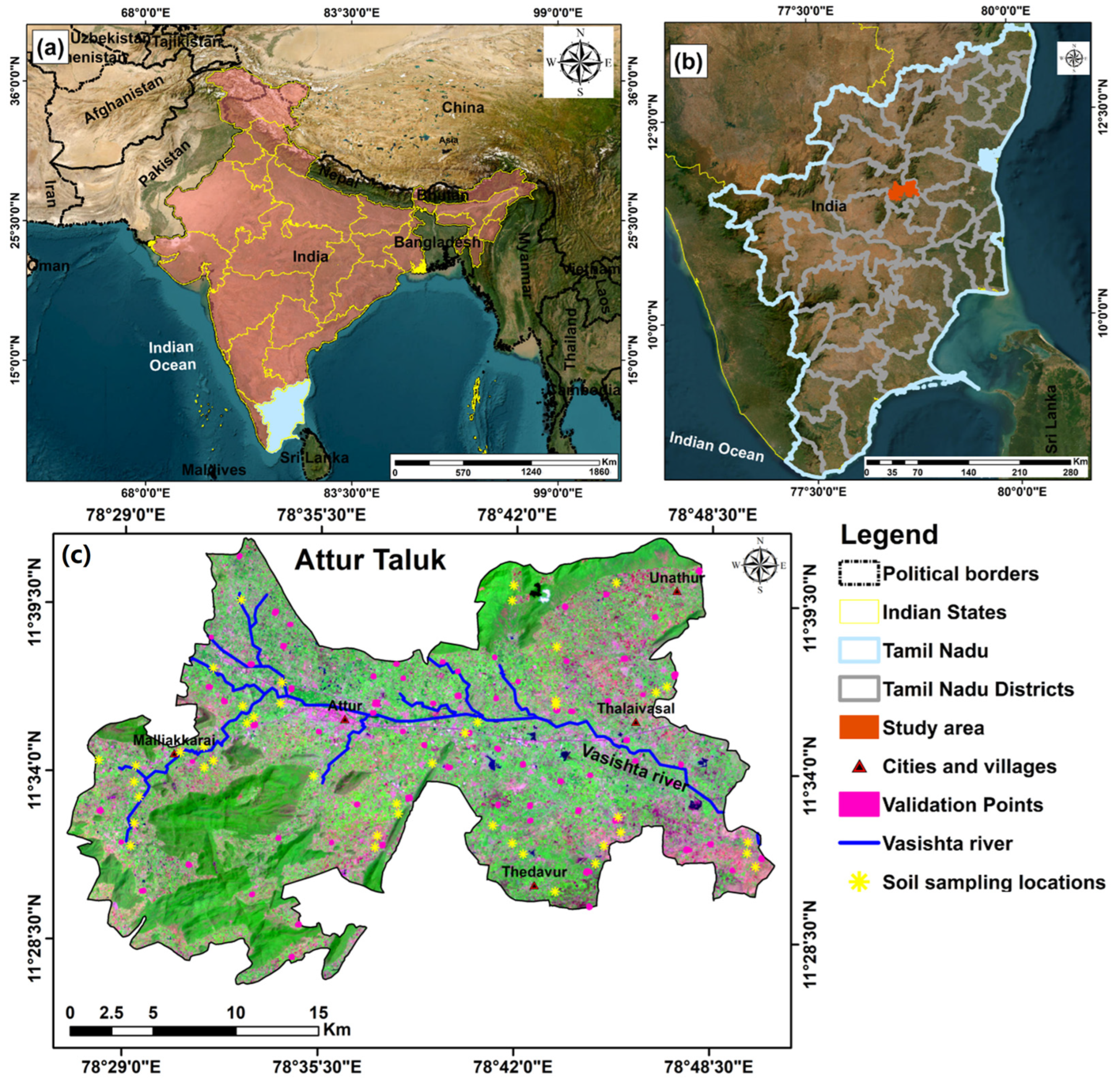
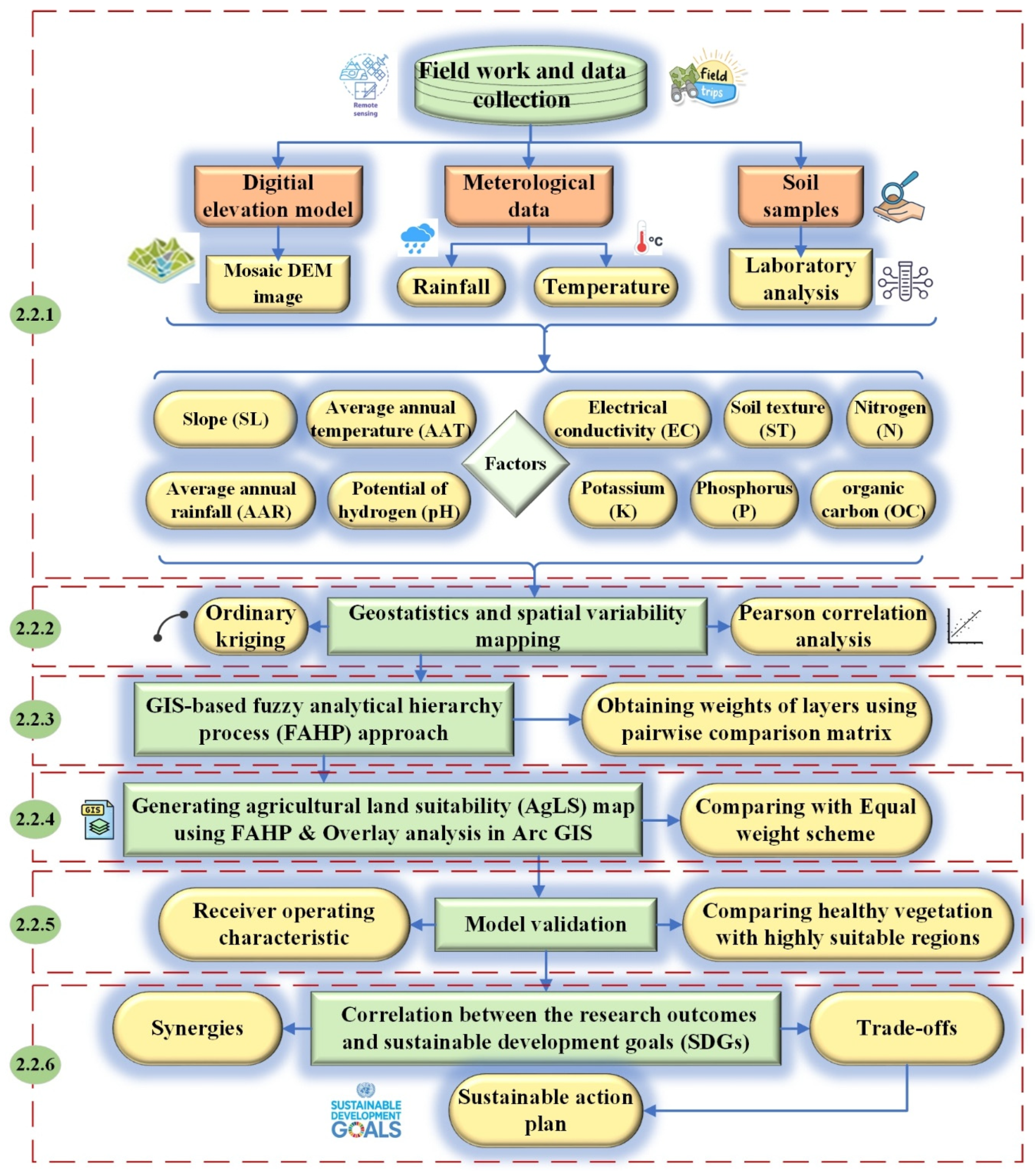


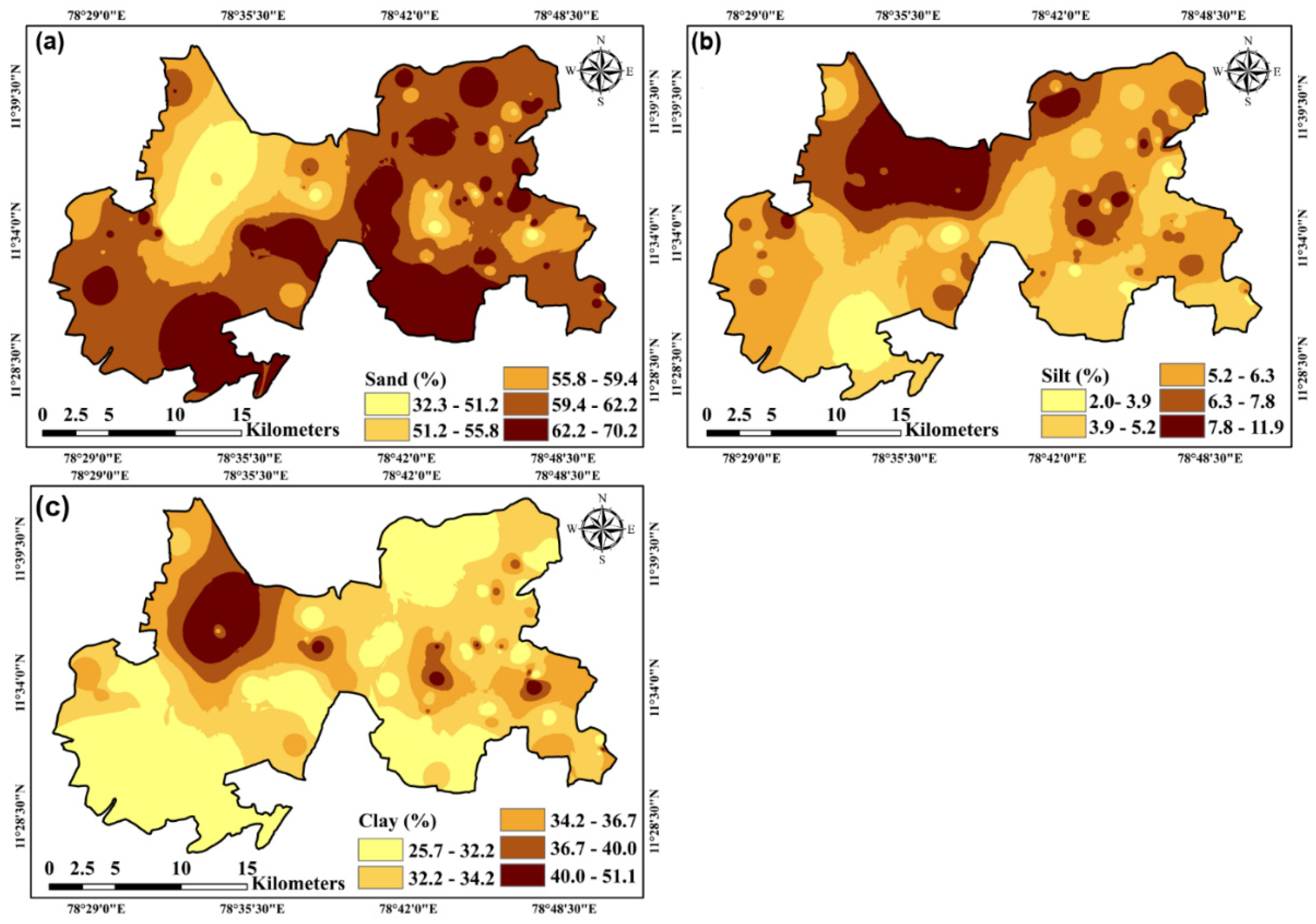
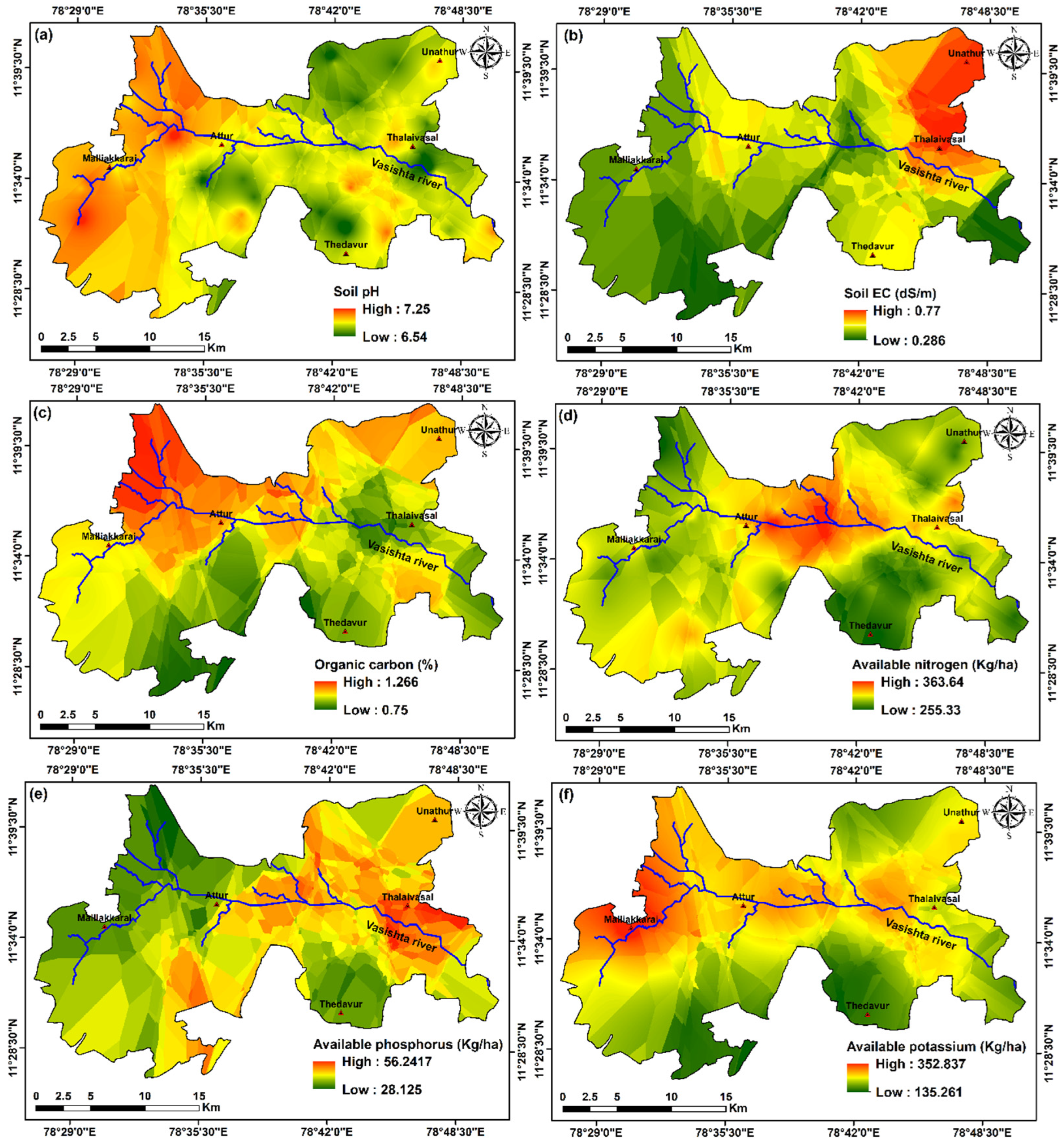
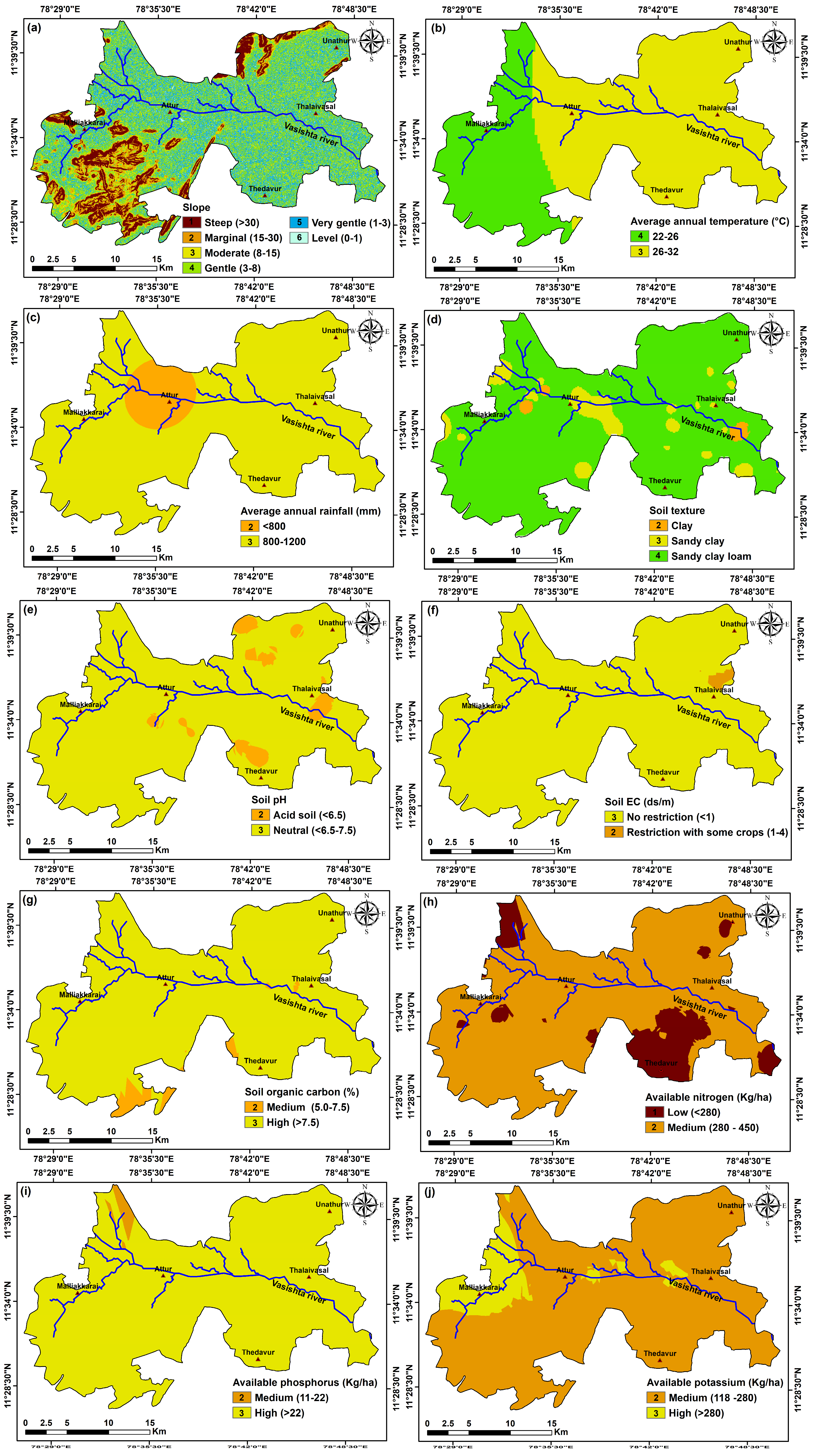



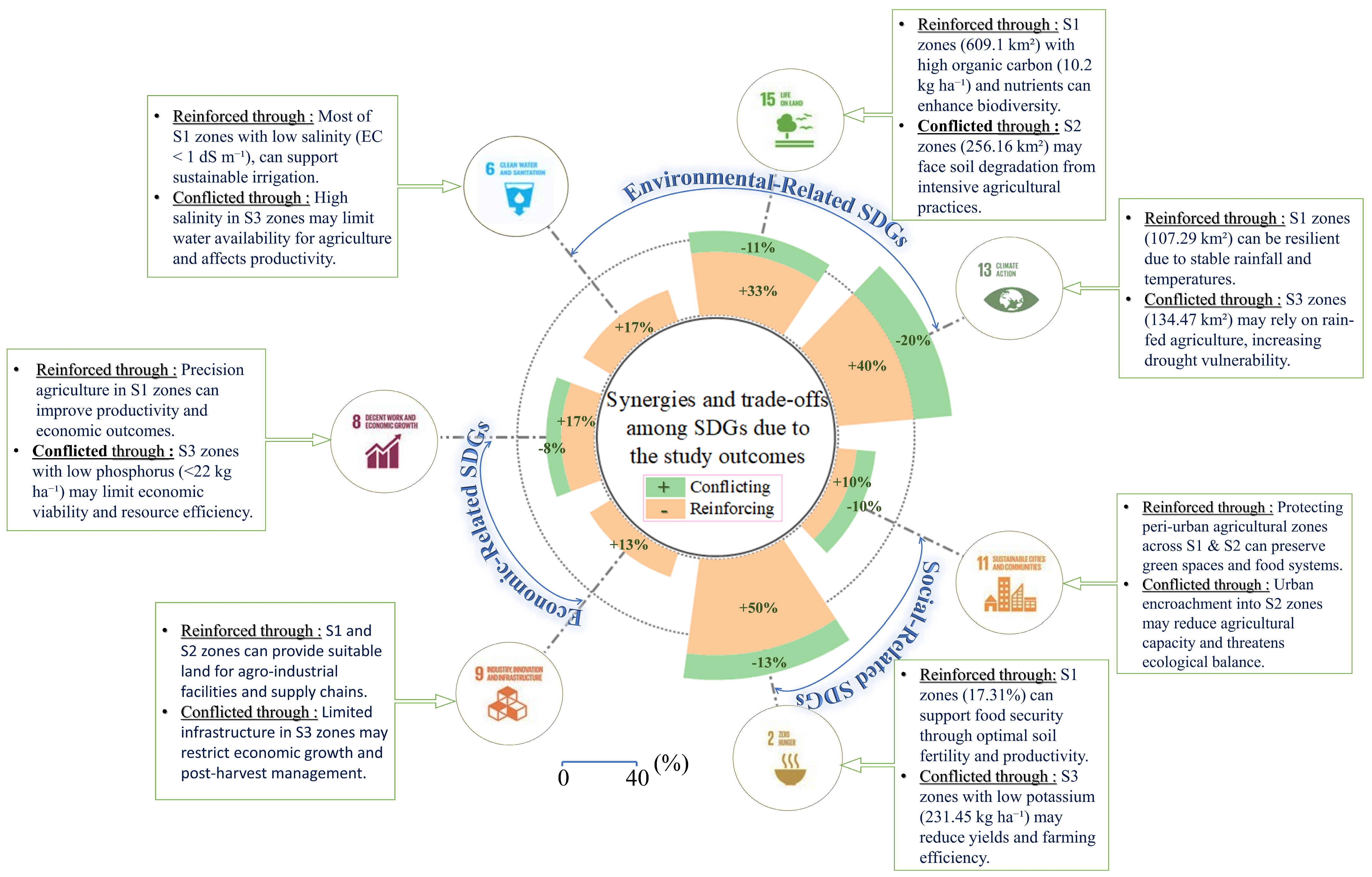
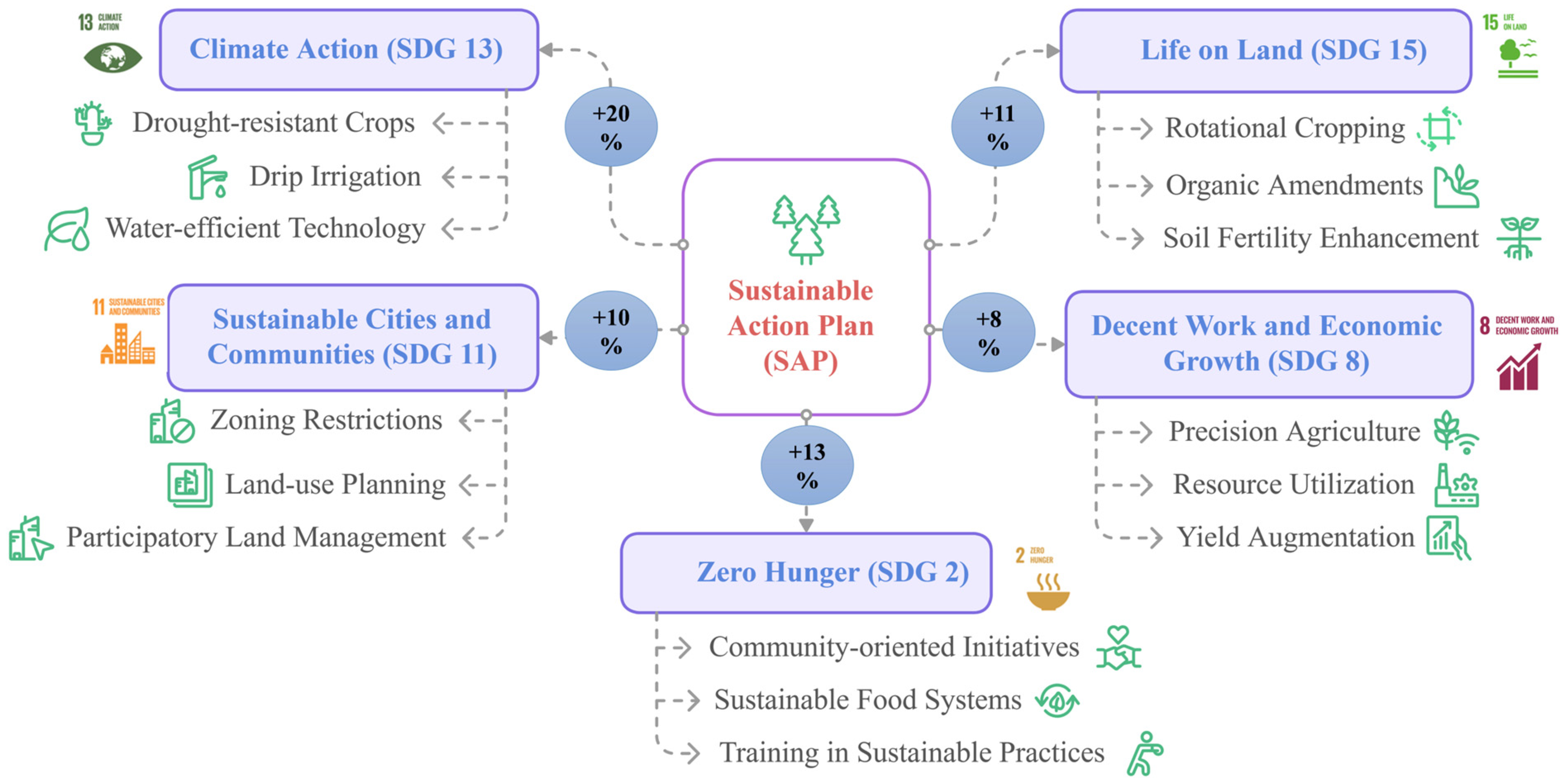
| Soil Parameter | Min. | Max. | Mean | SD | CV | Skewness | Kurtosis |
|---|---|---|---|---|---|---|---|
| pH | 6.20 | 7.54 | 6.92 | 0.28 | 4.05 | −0.47 | 0.07 |
| EC (dSm−1) | 0.12 | 1.24 | 0.46 | 0.29 | 63.04 | 1.13 | 0.44 |
| Sand (%) | 32.30 | 70.30 | 59.72 | 6.87 | 35.29 | −1.43 | 2.50 |
| Silt (%) | 2.00 | 12.00 | 6.01 | 2.30 | 19.63 | 0.48 | −0.36 |
| Clay (%) | 25.70 | 51.20 | 33.86 | 5.07 | 54.96 | 1.26 | 1.61 |
| OC | 3.40 | 20.0 | 10.2 | 3.6 | 56.59 | 0.60 | −0.32 |
| AN (kg ha−1) | 190.40 | 420.00 | 296.31 | 58.18 | 33.27 | 0.19 | −0.59 |
| AP (kg ha−1) | 10.40 | 88.30 | 39.68 | 21.81 | 43.08 | 0.64 | −0.57 |
| AK (kg ha−1) | 53.70 | 887.50 | 231.45 | 130.97 | 59.94 | 1.80 | 6.27 |
| Soil Parameters | pH | EC | OC | AN | AP | AK | Sand | Silt | Clay |
|---|---|---|---|---|---|---|---|---|---|
| pH | 1 | ||||||||
| EC | −0.125 | 1 | |||||||
| OC | 0.199 | 0.080 | 1 | ||||||
| AN | −0.147 | 0.226 * | 0.136 | 1 | |||||
| AP | −0.261 * | 0.173 | −0.010 | 0.192 | 1 | ||||
| AK | 0.139 | 0.054 | 0.225 * | 0.133 | 0.203 | 1 | |||
| Sand | −0.240 * | −0.035 | −0.338 ** | −0.060 | 0.156 | −0.373 ** | 1 | ||
| Silt | 0.205 | −0.026 | 0.319 ** | 0.028 | −0.148 | 0.334 ** | −0.533 ** | 1 | |
| Clay | 0.187 | −0.064 | 0.227 * | 0.103 | −0.194 | 0.267 * | −0.840 ** | 0.336 ** | 1 |
| Soil Parameters | Model | Nugget | Partial Sill | Range | Sill | Nugget/Sill Ratio | RMSE | Spatial Dependence |
|---|---|---|---|---|---|---|---|---|
| pH | Exponential | 0.0446 | 0.411 | 5898 | 0.456 | 0.098 | 0.95 | Strong |
| EC | Gaussian | 0.0206 | 0.107 | 1767 | 0.128 | 0.161 | 1.01 | Strong |
| Sand | Exponential | 9.8 | 36.52 | 1131 | 46.320 | 0.212 | 1.02 | Strong |
| Silt | Spherical | 3.92 | 2.03 | 16,875 | 5.950 | 0.659 | 1.02 | Moderate |
| Clay | Spherical | 0.25 | 0.493 | 24,033 | 0.743 | 0.336 | 0.99 | Moderate |
| OC | Spherical | 0.003 | 0.005 | 3246 | 0.008 | 0.375 | 1.09 | Moderate |
| AN | Exponential | 2464 | 1128 | 12,172 | 3592.000 | 0.686 | 1.03 | Moderate |
| AP | Exponential | 31 | 517.65 | 2145 | 548.650 | 0.057 | 1.01 | Strong |
| AK | Exponential | 5880 | 13,889 | 1131 | 19,769.000 | 0.297 | 0.94 | Moderate |
| Influencing Factor | Class | Class Weight | Factor Weight | Class Weight × Factor Weight |
|---|---|---|---|---|
| AAT (°C) | 22–26 | 4 | 0.224 | 0.896 |
| 18–22 or 26–32 | 3 | 0.672 | ||
| 14–18 or 33–15 | 2 | 0.448 | ||
| <14 or >35 | 1 | 0.224 | ||
| AAR (mm) | <800 | 1 | 0.191 | 0.191 |
| 800–1200 | 2 | 0.382 | ||
| <1200 | 3 | 0.573 | ||
| SL (%) | Level (0–1) | 6 | 0.160 | 0.8 |
| Very gentle SL (1–3) | 5 | 0.8 | ||
| Gentle SL (3–8) | 4 | 0.64 | ||
| Moderate SL (8–15) | 3 | 0.48 | ||
| Strong SL (15–30) | 2 | 0.32 | ||
| Steep SL (>30) | 1 | 0.16 | ||
| ST | Sandy clay loam | 4 | 0.047 | 0.188 |
| Sandy clay | 3 | 0.141 | ||
| Clay | 2 | 0.094 | ||
| Sandy | 1 | 0.047 | ||
| pH | Acidic soil (<6.5) | 2 | 0.102 | 0.204 |
| Neutral (<6.5–7.5) | 3 | 0.306 | ||
| Saline soil (7.5–8.5) | 2 | 0.204 | ||
| Alkaline soil (>8.5) | 1 | 0.16 | ||
| EC (dS m−1) | No restriction (<1) | 3 | 0.095 | 0.285 |
| Restriction with some crops (1–4) | 2 | 0.19 | ||
| Restricted with all crops (>4) | 1 | 0.095 | ||
| OC (Kg ha−1) | Low (<5.0) | 1 | 0.062 | 0.062 |
| Medium (5.0–7.5) | 2 | 0.124 | ||
| High (>7.5) | 3 | 0.186 | ||
| AN (Kg ha−1) | Low (<280) | 1 | 0.049 | 0.049 |
| Medium (280−450) | 2 | 0.098 | ||
| High (>450) | 3 | 0.147 | ||
| AP (Kg ha−1) | Low (<11) | 1 | 0.037 | 0.037 |
| Medium (11–22) | 2 | 0.074 | ||
| High (>22) | 3 | 0.111 | ||
| AK (Kg ha−1) | Low (<118) | 1 | 0.034 | 0.034 |
| Medium (118−280) | 2 | 0.068 | ||
| High (>280) | 3 | 0.102 |
| Suitability Class | AgLSEq | AgLSFAHP | ||||
|---|---|---|---|---|---|---|
| Area | Area | |||||
| (km2) | (ha) | (%) | (km2) | (ha) | (%) | |
| N2 | 41.94 | 4194 | 6.78 | 48.50 | 4850 | 7.82 |
| N1 | 107.34 | 10,734 | 17.34 | 73.56 | 7356 | 11.87 |
| S3 | 136.45 | 13,645 | 22.04 | 134.47 | 13,447 | 21.69 |
| S2 | 313.71 | 31,371 | 50.68 | 256.16 | 25,616 | 41.32 |
| S1 | 19.53 | 1953 | 3.16 | 107.29 | 10,729 | 17.31 |
Disclaimer/Publisher’s Note: The statements, opinions and data contained in all publications are solely those of the individual author(s) and contributor(s) and not of MDPI and/or the editor(s). MDPI and/or the editor(s) disclaim responsibility for any injury to people or property resulting from any ideas, methods, instructions or products referred to in the content. |
© 2025 by the authors. Licensee MDPI, Basel, Switzerland. This article is an open access article distributed under the terms and conditions of the Creative Commons Attribution (CC BY) license (https://creativecommons.org/licenses/by/4.0/).
Share and Cite
Sathiyamurthi, S.; Youssef, Y.M.; Gobi, R.; Ravi, A.; Alarifi, N.; Sivasakthi, M.; Praveen Kumar, S.; Dąbrowska, D.; Saqr, A.M. Optimal Land Selection for Agricultural Purposes Using Hybrid Geographic Information System–Fuzzy Analytic Hierarchy Process–Geostatistical Approach in Attur Taluk, India: Synergies and Trade-Offs Among Sustainable Development Goals. Sustainability 2025, 17, 809. https://doi.org/10.3390/su17030809
Sathiyamurthi S, Youssef YM, Gobi R, Ravi A, Alarifi N, Sivasakthi M, Praveen Kumar S, Dąbrowska D, Saqr AM. Optimal Land Selection for Agricultural Purposes Using Hybrid Geographic Information System–Fuzzy Analytic Hierarchy Process–Geostatistical Approach in Attur Taluk, India: Synergies and Trade-Offs Among Sustainable Development Goals. Sustainability. 2025; 17(3):809. https://doi.org/10.3390/su17030809
Chicago/Turabian StyleSathiyamurthi, Subbarayan, Youssef M. Youssef, Rengasamy Gobi, Arthi Ravi, Nassir Alarifi, Murugan Sivasakthi, Sivakumar Praveen Kumar, Dominika Dąbrowska, and Ahmed M. Saqr. 2025. "Optimal Land Selection for Agricultural Purposes Using Hybrid Geographic Information System–Fuzzy Analytic Hierarchy Process–Geostatistical Approach in Attur Taluk, India: Synergies and Trade-Offs Among Sustainable Development Goals" Sustainability 17, no. 3: 809. https://doi.org/10.3390/su17030809
APA StyleSathiyamurthi, S., Youssef, Y. M., Gobi, R., Ravi, A., Alarifi, N., Sivasakthi, M., Praveen Kumar, S., Dąbrowska, D., & Saqr, A. M. (2025). Optimal Land Selection for Agricultural Purposes Using Hybrid Geographic Information System–Fuzzy Analytic Hierarchy Process–Geostatistical Approach in Attur Taluk, India: Synergies and Trade-Offs Among Sustainable Development Goals. Sustainability, 17(3), 809. https://doi.org/10.3390/su17030809









